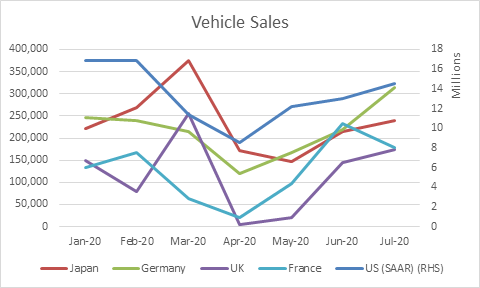
Auto Sales Drift into a U-Turn
The auto industry has been one of the hardest hit sectors since the pandemic began. In April, US auto sales hit a low of 8.6 million vehicles, down from 16.8 million at the end of February. Moody’s expects vehicles sales to fall at least 20% in 2020 and will take several years to return to 2019 levels. Over the last several months, as countries relax their stay at home orders and consumers take advantage of incentives to purchase cars, we have seen a stunning rebound in vehicle sales across the world.

Source: Ward, JAMA, FMVO, SMMT, FAMA, ANFIA, ANFAC
Vehicle sales in the US have rebounded 69% from their April low to an annualized rate of 14.5 million vehicles at the end of July. Initially, dealers put heavy incentives to push cars sales at the onset of the pandemic, opening its recession era playbook by offering large cash back offers, 0% interest rates and 7-year maturity terms. Consumer demand for cars have exceeded expectations as they take advantage of these new deals, while also shifting away from using public transportation and moving away from urban areas due to the pandemic. In addition, supplies have been dwindling due to production shutdowns to protect employees during the pandemic but have slowly ramped back up as manufacturers adjust to new health regulations and changing consumer demand. This has quickly adjusted inventory levels to meet reduced demand, which helps automakers be more flexible as economies open up.
Euro area governments have also implemented subsidies to incentivize consumers to purchase more energy-efficient cars. In France, automaker subsidies total around €8 billion this year and include increased subsides for electric vehicle purchases to €7,000, from €6,000 for consumers, and from €5,000 for businesses. In June, Germany announced a €130 billion economic stimulus package that included increased consumer rebates for purchases of battery electric vehicles and a VAT tax break down to 16% from 19% to stimulate consumer demand. The EV subsidies amount to as much as €9,000 per vehicle, and some consumers are able to lease an EV car for free. Although not providing direct subsidies to automakers, the US had insulated US citizens with a $1,200 stimulus check and kept afloat unemployed individuals with an extra $600 in Pandemic Unemployment Assistance that ended in July. Congress remains far apart on agreeing to additional assistance, but any additional direct payments will likely help US auto sales at the margins.
Over the last few months, it is safe to say that vehicles sales have bottomed, but there remains some risk that demand could falter entering the fall. A spike in consumer delinquencies has only recently moved higher as halted income subsidies no longer help to prop up the consumer, while banks have made massive reserves in anticipation of problems arising. A resurgence of the coronavirus is still a possibility in other parts of the world, and the US continues to struggle in keeping infection rates down. Certain parts of the US have had to shut down again, which could last three months if shut-down measures take a similar path as they did in March. Only recently have new cases of coronavirus trended lower, with the 5-day average new case rate hitting 41,000 from above 50,000 at the end of July. At a minimum, we should expect US auto sales to flatline for a period of months as consumers adjust to a rapidly changing reality.
Please click here for disclosure information: Our research is for personal, non-commercial use only. You may not copy, distribute or modify content contained on this Website without prior written authorization from Capital Advisors Group. By viewing this Website and/or downloading its content, you agree to the Terms of Use & Privacy Policy.
